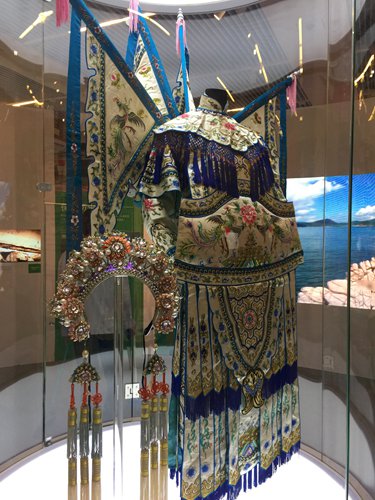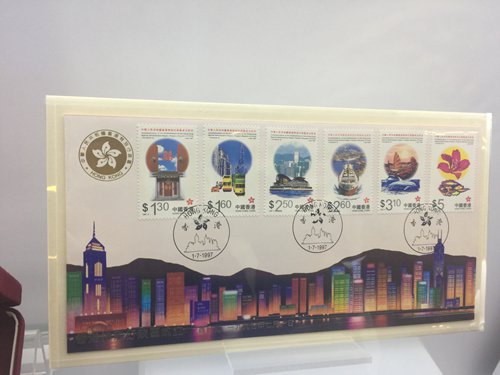
A traditional costume worn by Yue Opera singer Wu Junli Photo: Xu Liuliu/GT

A postcard with stamps commemorating Hong Kong's return to China on July 1, 1997. Photo: Xu Liuliu/GT
On Tuesday, Li Chunming took his 3-year-old daughter Li Zishun to the National Museum of China to see an exhibition outlining all the achievements the city of Hong Kong has achieved since it returned to China in 1997.
This was the first time the young girl had even heard the city's name, but after walking through the exhibition - especially a section dedicated to the city's two amusement parks Hong Kong Disneyland and Hong Kong Ocean Park - the girl pulled her father down to her and whispered, "I want to go to Hong Kong."
"I visited Hong Kong several years ago and enjoyed traveling around the city. Seeing these achievements, I'm thinking about going back… with my daughter of course," said the 32-year-old businessman who lives in East China's Shandong Province.
Hearts linked together
The HKSAR 20th Anniversary Exhibition opened to the public on Tuesday. The opening was a big success, especially with the help of a high-profile visit by President Xi Jinping and Leung Chun-ying, chief executive of HKSAR, to the exhibition on Monday.
"A bird's view of the exhibition hall reveals that it is made of several concentric circles, representing the idea that Hong Kong and the motherland are one," Mandy Wong, assistant director of the HKSAR office in Beijing, told the Global Times on Tuesday. "We are working together to realize the Chinese Dream."
The Hong Kong Special Administrative Region government spent two years preparing the exhibition so it could "fully introduce Hong Kong's development and progress over the past 20 years, as well as its bright future."
"Hong Kong is the place where East meets West, tradition meets modernity. With this in mind, we have used traditional ways to present this exhibition such as displaying items, photographs and videos, as well as including more modern presentation methods such as having interactive and multimedia installations," Wong said.
The opening section of the exhibition is an example of one of these interactive installations. The exhibit "collects" the hearts of visitors to show how much people love Hong Kong. By touching their palm to a sensor, visitors can "give their heart" to Hong Kong. A nearby screen then shows how many people have donated their hearts so far.
"The hearts of people in Hong Kong and in the mainland are closely linked together, which helps to make Hong Kong better and better," Wong explained.
Cultural exchanges
With 10 sections and the theme of "Togetherness," the exhibition showcases how Hong Kong and the mainland have worked together in fields such as trade, finance, culture, sports and technology over the years.
"People in the mainland began to really get to know Hong Kong during the 1970s and 1980s, mostly through the city's pop culture, from pop music, martial arts novels to film," Wong said, joking that her mainland friends often ask her if she can sing the theme song to the popular 1980 Hong Kong TV drama Shanghai Beach starring Chow Yun-fat.
In the section of the exhibition dedicated to culture, a large number of Hong Kong film posters are on display as well as some of the costumes worn by famous actors, such as the outfit actor Donni Yen wore in the 2008 movie An Empress and the Warriors.
The exhibition wasn't limited to pop culture, traditional culture, especially examples of the city's intangible cultural heritage, are also on display.
Yue Opera is very popular throughout South China's Guangdong Province, as well as Hong Kong and Macau. In 2006, it was listed as a national intangible cultural heritage in China, and in 2009 it was inscribed on UNESCO's Representative List of the Intangible Cultural Heritage of Humanity.
Eighty-seven-year-old actress Wu Junli is a figure that must be mentioned in any conversation about Yue Opera. Naturally, one of the costumes Wu wore during her performances in the 1960s and 1970s is there for visitors to see.
Wu donated a total of 3,000 Yue Opera items including this outfit to the Hong Kong Heritage Museum in 2004.
Among eight videos introducing Hong Kong's cultural heritage is one about two guqin masters. The first master is Cai Changzhou, a craftsman who makes the traditional seven-stringed musical instrument, while the other is Su Sidi, a guqin musician who enjoys a great reputation in both Hong Kong and the mainland.
"The culture of the guqin is a very personal type of art. Different performers have different tastes and styles," Cai says in the video, explaining that many performers would make their own musical instruments instead of having someone else do it. "Only by doing it themselves could they create an instrument that was the right fit for them."
According to Wong, while cultural exchange before 1997 mainly consisted of Hong Kong culture being exported to the mainland, things are quite different now.
"Now Hong Kong musicians head to the mainland to develop their careers and more and more films are coproductions between Hong Kong and the mainland," she said.
Grasping opportunities
According to a report from the Xinhua News Agency, when President Xi Jinping visited the exhibition, he called on Hong Kong to "grasp the opportunities of the country's development."
Wong noted that the exhibition demonstrates how Hong Kong is poised to seize new opportunities arising from China's 13th Five-Year Plan (2016-20) and the Belt and Road initiative.
Wong said she still remembers how the central government managed to help Hong Kong's economy recover from the impact of SARS through a series of policies such as making it easier for mainlanders to visit Hong Kong.
"Twenty years may not be quite a long time compared to the entirety of human history, but for Hong Kong and the motherland, every day of these past 20 years have counted," she said.
"We know that by staying together with the motherland, Hong Kong will have a better tomorrow."
The exhibition ends on July 16.

